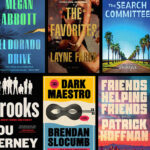A popular YouTuber recently described my upcoming thriller as “perfect for Halloween,” and that offhand comment stuck with me. Not because the book is scary (though it has its moments), but because it taps into something I’ve long sensed: October is crime fiction’s most atmospheric month.
Just as we reach for breezy beach reads in July and snow-drenched locked-room mysteries in February, October’s unsettling mood drives us to choose a different sort of book. There’s something about the dying of the year that makes us crave stories where secrets surface and violence lurks beneath.
It’s during October, when the darkness arrives earlier, when the air sharpens, that something feels…off. Crime fiction doesn’t just suit October—it thrives in it.
Maybe that’s why publishers choose to release some of their most atmospheric thrillers just as the leaves begin to turn.
*
When Seasons Shape Stories
Sometimes the season isn’t just mood—it’s plot. When I was writing my thriller, Long Way Down (Oct 21), I needed one of my characters—a marijuana grower in Northern California—to be at a critical point in her harvest when the buds are sticky, valuable, and, yes, worth killing for.
Suddenly the whole book bent to autumn’s rules: the deceptive calm of golden light, the snap of cold air that makes a whisper travel for miles, the shadows that stretch just a little too long.
*
Autumn’s Psychological Pull
As daylight shrinks and temperatures drop, we’re naturally drawn to stories that mirror our environment’s shift from light to dark. October releases like Nic Stone’s Boom Town (October 14)—set in Atlanta’s underground strip club scene—tap into that feeling of worlds hidden beneath the surface, of secrets that thrive in longer nights.
L. Divine’s Lost in the Garden of Eve (October 28) does something similar, following a former stripper-turned-reporter investigating missing dancers. There’s something about autumn that makes us want to peer into the shadows, to explore the underbelly of society as nature begins shedding its bright summer facade.
*
Ghosts, Memory, and the Things We Bury
Autumn is when we’re already feeling nostalgic, when every falling leaf reminds us that time passes and things change.
Vanessa Lillie’s The Bone Thief (October 28) kicks off just as summer camp winds down—that liminal moment when the innocence of vacation gives way to the hard truth of what’s been buried. Literally. In this case, archaeological remains surface as the season dies. Endings beget revelations.
In Kate Belli’s The Gallery Assistant (October 14), a woman wakes up in post-9/11 New York with no memory and a dead artist to account for. Autumn in NYC already carries weight, and adding that post-attack paranoia creates a perfect storm of unease.
Jennifer Fawcett’s Keep This for Me (October 7) takes us back to a small town where a mother vanished thirty years ago. Towns like these in autumn feel especially brittle—tight-knit yet emotionally abandoned, where secrets run so deep they’ve practically become part of the landscape.
Tom Ryan’s We Had a Hunch (Oct 14) taps into that same small-town claustrophobia, but with a YA twist. A group of teen detectives reunites to solve a new murder, but nostalgia curdles fast when old bonds strain and secrets resurface. It’s Scooby-Doo meets seasonal dread.
*
Isolation Season
There’s something about fall that makes isolation hit harder. October is when the walls close in, when even open spaces start to feel like traps.
In The Hitchhikers by Chevy Stevens (Oct 7), set in summer 1976, a couple trying to heal on the road invites in two strangers—and their RV becomes a rolling nightmare. Stevens traps her characters in what should be their sanctuary—their home on wheels—and turns it into a prison. Reading this kind of claustrophobic terror as the nights grow longer just hits different.
John Fram’s The Midnight Knock (Oct 21) dials this claustrophobia up to eleven. A group of travelers, a sketchy Texas motel, and a murder ultimatum: solve the crime by midnight, or the lights go out and everyone dies. The setup is pure autumn suspense: isolation, contraction, encroaching dark.
Joe Hill’s King Sorrow (Oct 21) works similar terrain, set in a modern mansion that might as well be a gothic castle. Secrets, shadows, and the terrifying thinness of the veil between worlds. It’s the season for haunted houses, whether the ghosts are real or not.
*
Why October Thrillers Work So Damn Well
What all these October releases understand—what they lean into—is that autumn doesn’t lie. Spring offers hope, summer gives escape, winter cleanses. But autumn? Autumn strips everything down to bone. It doesn’t promise renewal. It promises revelation.
The dying of the year becomes the perfect metaphor for the death of secrets, the way truth emerges when everything else falls away.The dying of the year becomes the perfect metaphor for the death of secrets, the way truth emerges when everything else falls away. As readers, we crave this brutal honesty as the year begins to wind down.
We want stories that match the season’s mood: beautiful but melancholy, comfortable but tinged with unease. We want mysteries that unfold like leaves changing color—gradually, then all at once, revealing what was always there hiding beneath the surface.
That’s what crime fiction is all about: pulling back the curtain. Ripping up the floorboards. Finding the thing you didn’t want to see but can’t look away from. We read thrillers in October because we’re already in that state of mind—nostalgic, unsettled, suspicious.
So maybe that YouTuber was onto something. Maybe my book is perfect for Halloween. Not because it’s a horror novel, but because it does what autumn thrillers do best—it watches the leaves fall, listens to the wind rattle the windows, and asks: What’s been hiding here all along?
***


















